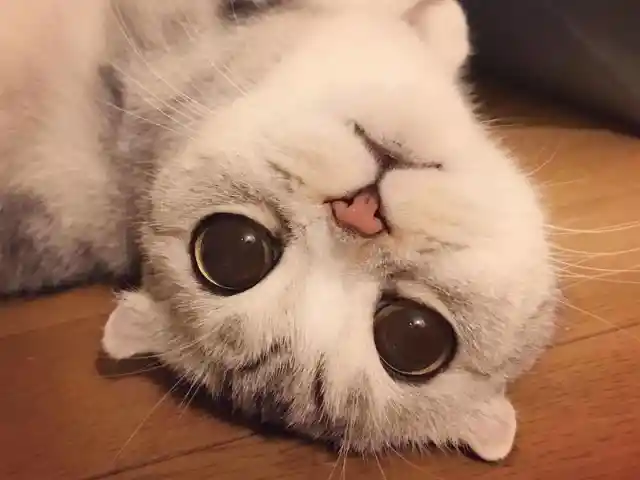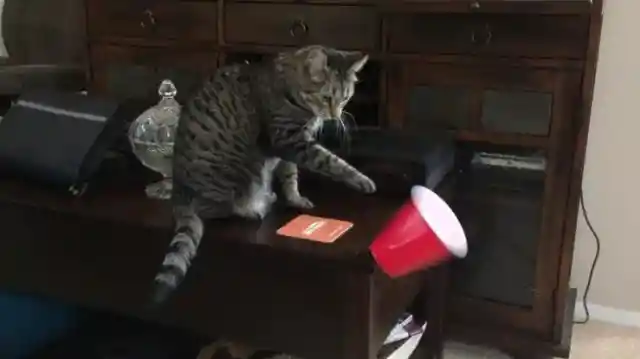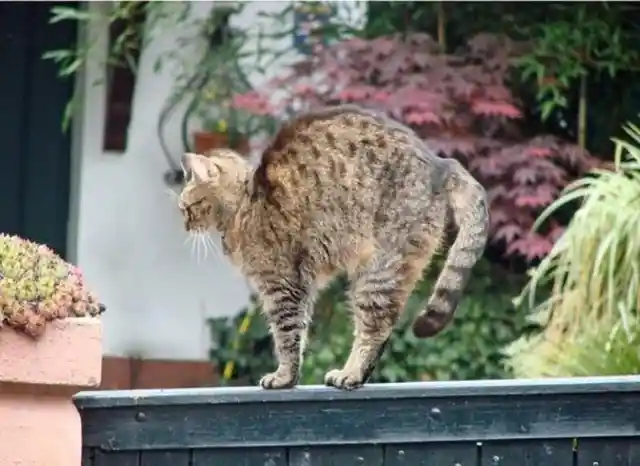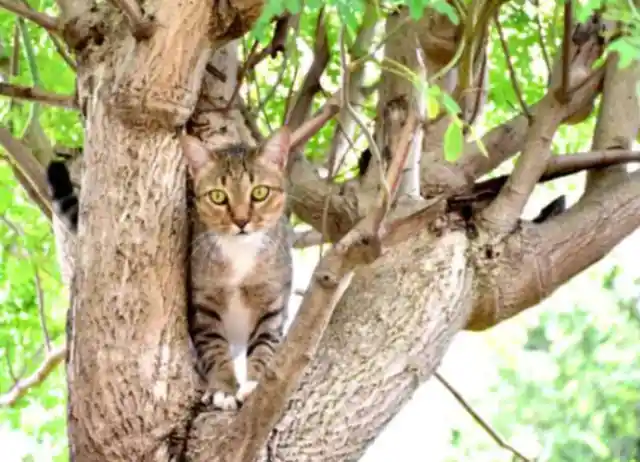Cats are a funny bunch. Although our furry companions can sometimes drive us up the wall, you’ve got to hand it to them—their wild antics make for hilarious action film footage. It can be hard to understand the behaviors of our beloved cats as they can be so mysterious at times.

They scratch up our furniture, race around the house, sleep on our keyboards, and parade around like they own the place. Of course, some of us are already familiar with silly cat behavior—such as their eternal battle with curtains or thousand-yard stare.
But if you’re curious about the meanings behind some other feline behaviors, read on!
Cat Zoomies
Cats can usually be seen dashing around the house. This type of behavior, also known as the “zoomies,” will happen without any prior notice or prompting. In recent history, cats have developed a diminished need to hunt, hold their ground, or defend themselves against predators.

But their bodies still instinctively retain reserve energy for these pursuits just in case the need arises. A nice zoom around the house is a terrific way to get rid of their unused fuel, as chaotic and strange as it may seem to us.
Slow Blinking
Cats have a reputation for keeping their emotions hidden. Discerning if your cat sees you as an object of affection or a bothersome vending machine can be tricky. If you’re in love with your cat, you can tell if they reciprocate your feelings by watching how they look at you.

If your cat gazes at you and slowly blinks back at you, it’s a sign that they love you! When a cat blinks slowly, it means that you are its carer and that the cat wants you to know that they like having you around.
Coughing Up Hairballs
Coughing up hairballs is a well-known feline behavior. However, your kitty isn’t dabbling in artistic expression—it’s simply practicing good hygiene by grooming itself. By licking its body, your cat takes good care of its skin and fur.

Microscopic hooks on its tongue assist in the removal of unneeded body hair. Because some fur is ingested, it accumulates in the animal’s stomach. Your cat will cough up a hairball once in a while to clear the buildup.
Following You Everywhere
No, it’s not a hairy shadow following you around your home—it’s your kitty. Occasionally, your cat might follow you everywhere you go. In most cases, it’s because your cat simply wants to spend time with you!

Cats spend the majority of their lives alone in the house. However, just like people, cats crave company and entertainment, and they’ve chosen you as the best source of both! It allows your cat to leave its fragrance and delineate its territory everywhere you go as well.
Opening Doors
Due to their traditional godly place in ancient Egyptian society, cats appear to have an entitlement problem. There is no doubt in their minds that your home is their domain. They own every inch of the place! That’s why cats hate closed doors—they hate being denied anything.

They go insane at the mere thought of being cut off from parts of their domain. They’ll do whatever it takes to get the door unlocked. This might include scratching, meowing, and attempting to pull door handles down. Kittens are sociable creatures, so being shut out also means missing out on human interaction. That’s right; cats have a fear of missing out, too!
Head Bumps
Getting a tiny head bump, or “bunting,” from your cat is a sign that you’re on its good side! Petting your cat will cause it to spray you with its pheromones. This lets you know that it regards you as one of its own, which is code for “I love you.”

Bunting can also help cats create a sense of calm and security in a tense atmosphere. They’ll feel perfectly at home with a few head rubs on various items about the room. If they’re in a new place, it’s likely they just need to make the place feel a bit more homely.
Scruffing
Scruffing is when mother cats carry their kittens around by the thick skin of their necks. It’s a brilliant approach to keeping kittens safe, even if it doesn’t appear kind. Kittens have extra skin there, so it doesn’t actually hurt them.

As soon as a kitten is caught by the neck, it will become limp. This allows the mother cat to quickly move her kittens to safety without fearing that her wiggling offspring will tumble out of her clutches and into danger.
Wandering
Felines are very self-sufficient animals. They enjoy cuddling with their owners and getting their heads rubbed, but they also require time to re-energize and recuperate after too much socializing. So if you haven’t seen your kitty for a few days, don’t fret.

It’s exciting to explore the world on your own and see and smell things you’ve never seen before. This is an excellent way for your cat to get some peace in a busy household. Eventually, your kitty will return, most likely to its food bowl.
The Cat’s Eye
When it comes to dilation, it’s always good to keep an eye out. While it can be cute, it can also be quite unnerving. When your cat’s eyes are fully dilated, staring into your cat’s eyes can be a little frightening. Their eyes are more likely to do this when it’s dark outside when cats are actively hunting their prey.

Their pupils will widen to let in as much light as possible to ensure that they catch a glimpse of their dinner before it runs away. If you see this in the daytime, it could be a sign of stress or the onset of heat if your cat is female.
Knocking Things Over
Everybody has caught their cat red-pawed after hearing their valuables fall to the ground at least once. No, your cat did not purposefully drop your valuable vase on the floor. It’s all because of boredom! Cats use their paws to explore the textures and objects in their surroundings.

If your cat has been on a “knocking things from the shelf” spree lately, it might be a good time for a change of scenery. A few new toys or a location shift may be all you need to keep your valuables safe.
Sitting On Top Of Your Work
Has your cat ever sat on top of your work? This might include your paperwork, workbench, or keyboard. Do they want you to take a rest? Nope! Your cat is attracted to your fragrance because it feels comfortable around you. Cats’ territorial nature also contributes to this trait.

They know that whatever has your full attention must be important, and they want in! They claim possession of anything they walk on with their pheromone glands. It’s true—your cat thinks your laptop is theirs.
Grass-Eating
Cats love eating grass. Even though it is unpalatable to humans, it is essential to your cat’s health! Folic acid, abundant in the grass, helps a cat’s body manufacture hemoglobin, which is essential to its survival.

Vomiting food they can’t digest helps keep cats’ bowel motions regular and prevents them from getting ill due to a sour stomach. As a result, feel free to feed your cat some grass for dinner—or just let them go outside so they can do it themselves.
Afraid of the Water
Water goes in the bowl, not over the coat. Splashy splash time with your cat might sound like fun to humans, but not to cats. Because they don’t like their fur getting wet, it’s reasonable that they’d want to flee from water by doing what they know best—clawing and jumping.

When it comes to grooming your pet, bathing is not only unnecessary, but it also infuses their fur with a weird texture and taste. If your cat’s fur is damp, it will slow them down and make them less agile. So rather than cleaning your cat, you can relax in the tub. Let them handle it.
Occasional Water Lovers
Not all cats hate water! It may seem odd, but certain feline breeds have a natural affinity for getting wet. Some breeds of cats enjoy taking a bath in the water, such as Bengals, Turkish angoras, and Japanese bobtails.

Cats are drawn to moving items, so a dripping faucet could be a source of amusement for your pet. Your cat will spend hours trying to swat water droplets while listening to the weird sound of water hitting the sink. Just remember that only certain breeds enjoy getting in the water!
Cat In A Box
Has your cat ever been more pleased about the cardboard box it came in than the beautiful new toy you purchased? Cats are fascinated by cardboard boxes! Because of the small, cozy space they provide, cats can easily hide from predators there.

Cardboard is also a good conductor of heat. Cats enjoy being warm, so a cardboard box makes a convenient cat sauna. At the same time, it’s also perfect for chewing and scratching because it’s neither too soft nor too rough.
Exposing Their Belly
Warning! Do not give a cat a tummy rub when it exposes its belly. Unlike dogs, an exposed stomach does not mean it wants a belly rub. Cats will immediately claw or attack anyone who gets too close to their stomach. After all, that’s where all their vital organs are located.

So if they don’t like belly massages, why do they show their stomachs? It’s their way of showing you that they trust you and feel secure around you. What you lose in being able to give fluffy belly rubs, you gain in your cat’s trust.
Burying Droppings
A cat’s ability to bury its waste in the sand is an intriguing characteristic. While it may not be the cleanest way to play “find the buried treasure,” it’s more hygienic than just leaving it out in the open. Each dropping retains a unique aroma from the cat that left it.

If a cat is trying to elude a predator, this is bad. Even though modern house cats don’t have to fret about predators, they still have the impulse to bury their waste. You can help make your kitty feel safe by helping them hide their droppings with kitty litter or sand.
Not Burying Droppings
Self-assured cats may urinate in plain sight for all to see and smell. It’s not the most appealing cat behavior, but it’s natural. In addition, cats may leave exposed droppings throughout the house to establish their territory.

This behavior is to be expected when a new cat is introduced into the household. When you see a lot of cat droppings, it could be because your cat doesn’t like the litterbox conditions. The smell of the sand or the state of the box could be the problem.
Cat Stretching
In yoga, an arched back is referred to as the “cat pose” because it resembles a stretching cat. Kitties will often arch their backs after a long slumber to gain some much-needed exercise. Typically, a cat’s back also arches to show fear or defend its domain.

As a means of fending off any prospective threats, its body stretches to seem bigger and more intimidating. Your cat can become a fearsome feline threat with just a few hisses and raised hairs on the back of its neck!
Shallow Sleep
When it comes to “sleeping with one eye open,” cats take it to a whole new level. They can sleep with one eye open and one closed or with half-open, half-closed eyes. That’s a very intriguing way of dozing off.

The term “shallow sleep” refers to a cat’s ability to obtain some shut-eye even if it doesn’t feel entirely at ease in its surroundings. This kind of sleeping allows a cat to keep an eye on danger while also receiving some much-needed respite.
Getting Stuck Up Trees
Cats have no issue scaling trees, whether to chase after a meal or escape a predator. Their nimble physique and razor-sharp claws make it possible for them to scramble to new heights. Unfortunately, there are times when a cat climbs too high amid the uproar and becomes stuck.

Tree-climbing is a challenge for cats, whose innate nature is to jump rather than climb. This causes some hesitancy and delays their descent. However, with a bit of coaxing with tempting goodies, cats will ultimately learn the confidence to descend safely.
Chasing Lasers
While chasing a small red dot around the floor or walls may appear to be a tedious game to most people, it is a favorite pastime for cats. It checks off all necessary boxes to arouse your feline’s natural predator instincts.

Cats appreciate this activity because it allows them to exercise their natural hunting abilities while enjoying an excellent workout. Your cat’s superb peripheral vision and tracking skills will enable it to locate and track the laser pointer anywhere you aim. The dot is also an excellent reusable toy that won’t be shredded to pieces after two minutes.
Technological Geeks
Just like people, cats have been known to become engrossed in technological devices. Cats use the same senses to hunt fast-moving animals when they hear weird noises and see images on a computer, TV, or tablet.

Your cat will be mesmerized for hours if you play a video of birds chirping again and over. But they’re no longer restricted to passive viewing—they can now actively participate! Cats can play e-games designed explicitly for them!
Chattering
No, your cat isn’t trying to talk to you while looking out the window. Cats often make chitter-chatter when they watch birds perched high in the trees, out of reach. It could indicate that your cat is eager to eat its prey.

Others claim that in some cases, it’s used as a hunting tactic. The sound your cat produces is like that of a bird’s chirp, which may draw their feathered prey closer to the source of the sound, at which point the cat can strike from the shadows.
Taking a Soft Landing
Every time a cat jumps, it will always land on all fours—no matter the distance. This is because cats have a “righting reflex” that kicks in while falling from a considerable height, allowing them to survive most drops.

Despite cats’ apparent skill in achieving this acrobatic feat, it is only an instinctive reaction that prevents them from landing on their side or back. However, they can twist their way out of a bad landing thanks to their highly-tuned ears and incredibly flexible bone structure.
Playing With Shape Tape
Your cat will always find a way to foil your plans. With some tape, anyone can participate in the latest viral social media cat fad. Cats’ eyes are intended for seeing long distances—they aren’t ideal for close-up examination work or reading.

Because cats adore boxes so much, they may mistake a flat square shape for a three-dimensional cube. Cats see a whole new world when pieces of tape appear on the floor. Ignorance may be bliss after all.
Baking Bread
Your cat’s kneading or “making bread dough” doesn’t mean it’s a professional baker. When a cat presses its paws into a soft surface, it might purr and drool while doing so. But again, it isn’t thinking about tasty confectionery.

Kittens knead their mothers while drinking milk to stimulate their moms’ milk glands. The sensation of “kneading dough” makes cats feel comfortable and secure, just as they felt around their mothers as kittens. Kneading also produces pheromones from their paw glands. It allows them to claim a favorite blanket as their own.
Hating On Dogs
Most people who have ever watched a cartoon must know this one. Cats and dogs can have opposing personalities, making the maintenance of a close friendship challenging. Also, because cats are naturally solitary, it takes time for them to feel comfortable near other animals.

On the other hand, dogs are significantly more sociable and laid-back than cats. They’re eager to come close to any animal and smell it. Cats aren’t used to this kind of raucous approach. Scratching and barking usually follow. It’s the origin of the phrase “fighting like cats and dogs!”
Nap In The Fetal Position
Most cats curl up into a ball with their tails around their middle and their chin against their breast. Cats enjoy sleeping in this position because it keeps them warm. This shape also hides their tummies, protecting their vital organs from predators.

As well as doing it for comfort, there’s a chance that your cat is in the fetal position because of pain or discomfort. If the fetal position is your cat’s default sleeping position, this might be the case. Watch your cat’s sleeping habits with this in mind.
Fear of Cucumbers
Enter the term “cat frightened of cucumber” into the search bar of your preferred search engine. You may come across footage of cats fleeing in fright after being confronted with the terrifying vegetable, then burst out laughing at the silliness of the situation.

The size and shape of a cucumber may cause a cat’s brain to alert it to the presence of a snake. If you think about it, this might explain why cats get so scared of this inane inanimate object. For them, it may well be a life and death situation! For us, it’s an amusing little sketch.
